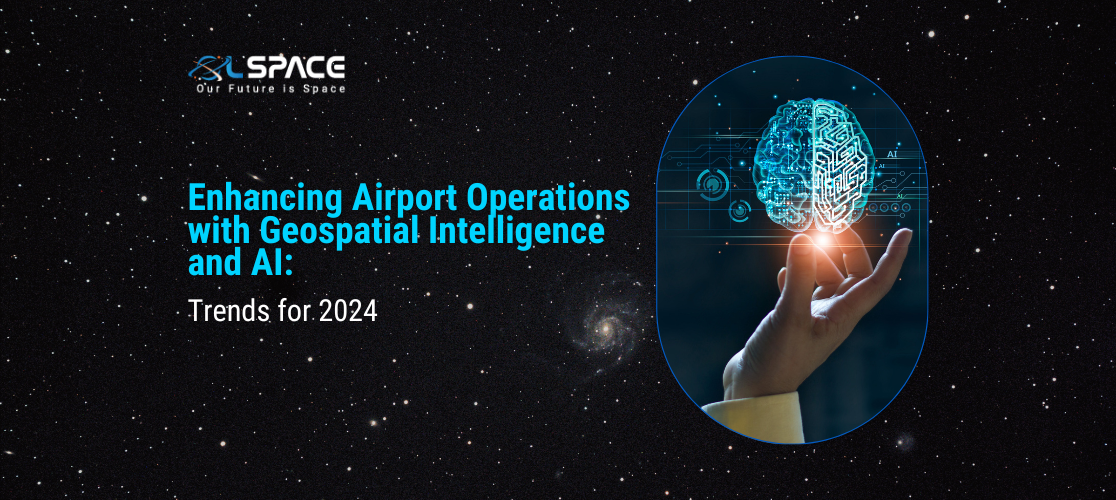23 February 2024
Enhancing Airport Operations with Geospatial Intelligence and AI: Trends for 2024

Airports are complex ecosystems that require precise coordination and management to ensure efficient operations and passenger satisfaction. In 2024, the integration of geospatial intelligence (GI) and artificial intelligence (AI) is set to revolutionise airport operations, enabling airports to optimise resources, enhance safety, and improve the passenger experience. This article explores the trends shaping the use of GI and AI in airport operations in 2024.
Geospatial Mapping for Infrastructure Management:
In 2024, airports will leverage geospatial mapping technologies to manage infrastructure more effectively. High-resolution satellite imagery and LiDAR data will enable airports to create detailed maps of their facilities, including runways, terminals, taxiways, and parking areas. These maps will support infrastructure maintenance, planning, and expansion efforts, ensuring optimal utilisation of airport resources.
AI-Powered Traffic Management Systems:
AI-powered traffic management systems will play a crucial role in optimising aircraft movements on the ground and in the airspace. AI algorithms will analyse real-time data on aircraft trajectories, weather conditions, and airport operations to predict congestion hotspots and optimise traffic flow. By reducing taxiing times and minimising delays, AI-powered traffic management systems will enhance efficiency and reduce fuel consumption.
Predictive Maintenance and Asset Management:
Predictive maintenance powered by AI will enable airports to identify and address equipment failures before they occur. AI algorithms will analyse sensor data from critical infrastructure components, such as runway lights, baggage handling systems, and air conditioning units, to detect anomalies and predict maintenance needs. This proactive approach to asset management will minimise downtime and ensure the reliability of airport operations.
Geofencing for Safety and Security:
Geofencing technology will enhance safety and security at airports by creating virtual boundaries around sensitive areas. AI algorithms will monitor aircraft and vehicle movements within designated geofenced zones and alert airport authorities to unauthorised intrusions or potential safety hazards. Geofencing will help prevent runway incursions, perimeter breaches, and other security incidents, improving overall airport safety.
AI-Powered Passenger Analytics:
AI-powered passenger analytics will enable airports to better understand and anticipate passenger behavior. By analysing data from security checkpoints, boarding gates, and retail outlets, AI algorithms will identify patterns and trends in passenger movements and preferences. This insight will help airports optimise passenger flow, streamline operations, and enhance the overall passenger experience.
Dynamic Resource Allocation:
AI algorithms will enable airports to dynamically allocate resources, such as gates, check-in counters, and security lanes, based on real-time demand. By analysing data on flight schedules, passenger volumes, and staffing levels, AI systems will optimise resource utilisation and minimise wait times for passengers. This dynamic approach to resource allocation will improve operational efficiency and enhance the passenger experience.
Environmental Monitoring and Sustainability:
Geospatial intelligence will play a crucial role in environmental monitoring and sustainability initiatives at airports. Satellite imagery and GIS data will enable airports to track emissions, noise levels, and wildlife habitats in their vicinity. AI algorithms will analyse this data to identify opportunities for reducing environmental impact, such as optimising flight paths, implementing noise abatement procedures, and conserving natural resources.
Robust Emergency Response Planning:
AI-powered simulation tools will enable airports to develop robust emergency response plans and conduct virtual drills to test their effectiveness. AI algorithms will simulate various emergency scenarios, such as aircraft accidents, security breaches, and natural disasters, to evaluate the airport’s readiness to respond. This proactive approach to emergency planning will enhance safety and resilience in the face of unforeseen events.
Collaborative Decision-Making Platforms:
Collaborative decision-making platforms powered by AI will facilitate communication and coordination among airport stakeholders, including airlines, air traffic control, and ground handling services. These platforms will provide real-time visibility into airport operations, enabling stakeholders to share information, coordinate activities, and respond swiftly to disruptions. By fostering collaboration and information sharing, AI-powered decision-making platforms will improve overall operational efficiency.
Continuous Innovation and Adaptation:
In 2024, airports will continue to innovate and adapt to emerging trends and technologies in GI and AI. By investing in research and development, fostering partnerships with technology providers, and embracing a culture of innovation, airports will stay at the forefront of technological advancement. This continuous pursuit of innovation will enable airports to meet the evolving needs of passengers, airlines, and other stakeholders, ensuring their long-term success and competitiveness.
Conclusion:
In 2024, the integration of geospatial intelligence and artificial intelligence will revolutionise airport operations, enhancing efficiency, safety, and sustainability. By leveraging GI and AI technologies, airports will optimise resource allocation, improve passenger experiences, and respond effectively to dynamic operational challenges. As airports continue to embrace innovation and technological advancement, they will remain key drivers of economic growth and connectivity in an increasingly interconnected world.
